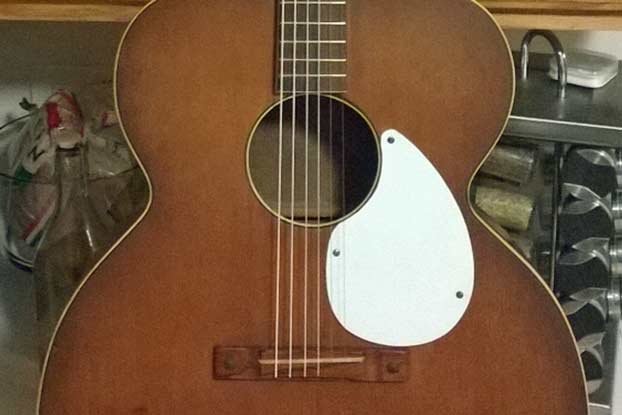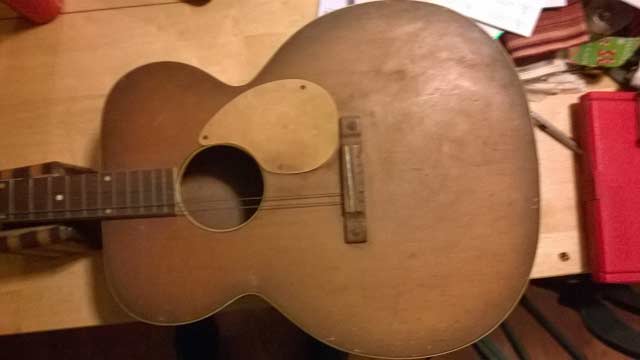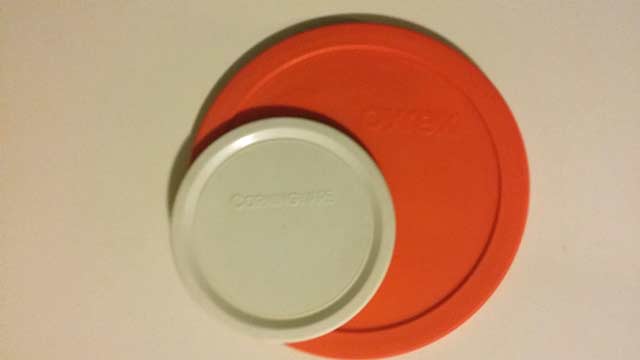Guitar 911: How to Make a Pickguard Out of a Tupperware Lid
A rather unconventional option for a pickguard replacement on a vintage guitar.

Today we're going to talk about a rather unconventional option for a pickguard replacement on a vintage guitar.
To be more precise, we're dealing with a vintage Silvertone. This isn't any vintage Silvertone, though. This Silvertone happens to be the largest (Silvertone or Kay) jumbo acoustic ever made. That's why it was known as the "Master Size."
These guitars also were known as 618's or K-22's and were made from the mid-Fifties to the mid-Sixties, making this sucker about 60 years old.
These guitars have what is probably the lowest, darkest bass tone, ever, in an acoustic guitar. If I were going to play metal on an acoustic guitar, this is the guitar I'd choose. This is due, in part, to its design and age and the effect time has on an instrument's tone.
I picked one up for about $50 on Craigslist. For me, this is a classic standard restoration job, a total score. Clean it up, reset the neck, glue everything back in place after cleaning it, replace the Kluson tuners and hardware, do some touch-ups, adjust the action and bammo! Another rare guitar gets introduced to my collection. But in this case, there was one item that eluded me. The pickguard.

I don't know how this guitar had been stored, but it looked like something I'd seen a few times before: a Louisiana screened-in back porch. So the dirt that embedded itself into the guitar was literally that—rain and soil. It had ruined the one thing I couldn't restore without some really hard work—the plastic pickgaurd. And it was warped, to boot. No amount of cleaning was going to fix it, and this type of plastic doesn't play well with the microwave trick (more on that in a future column).
Go ahead. Look for pickguard for a Silvertone Master Size 618 on eBay. I'm waiting....
So here's what I did. I reverted to my childhood and looked around the house. And what did I find?

Pyrex/Corningware/Tupperware lids. I call them "Tupperware lids" in the headline because it helps you form an immediate mental picture. They're the same thickness as most pickguards, within .003 of an inch. They're also soft. You can trace the original outline with a pencil and cut them with scissors and finish the cut with a file and sandpaper.
And since this pickguard gets screwed on instead of adhered, this makes the job all that much easier. Trace, cut, finish, apply.
And there's your zero-dollar fix on the fly. I didn't say zero work, I said zero dollar. You can see the finished product in the photo at the top of this story.
Check out Joe Becker online at joebeckermusic.com.
Get The Pick Newsletter
All the latest guitar news, interviews, lessons, reviews, deals and more, direct to your inbox!
“There are so many sounds to be discovered when you get away from using a pick”: Jared James Nichols shows you how to add “snap, crackle and pop” to your playing with banjo rolls and string snaps
Don't let chord inversions bamboozle you. It's simply the case of shuffling the notes around







![Joe Bonamassa [left] wears a deep blue suit and polka-dotted shirt and plays his green refin Strat; the late Irish blues legend Rory Gallagher [right] screams and inflicts some punishment on his heavily worn number one Stratocaster.](https://cdn.mos.cms.futurecdn.net/cw28h7UBcTVfTLs7p7eiLe.jpg)


